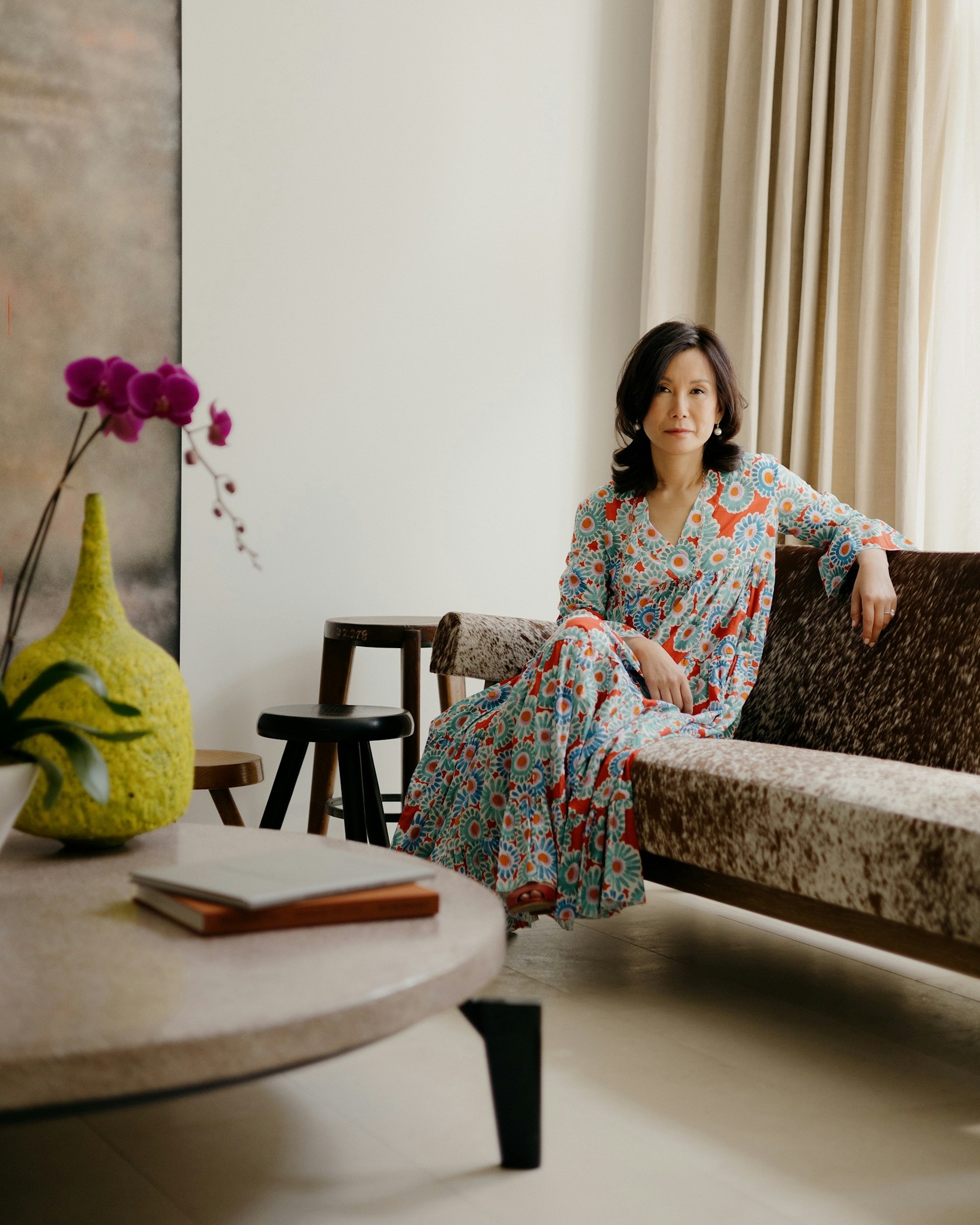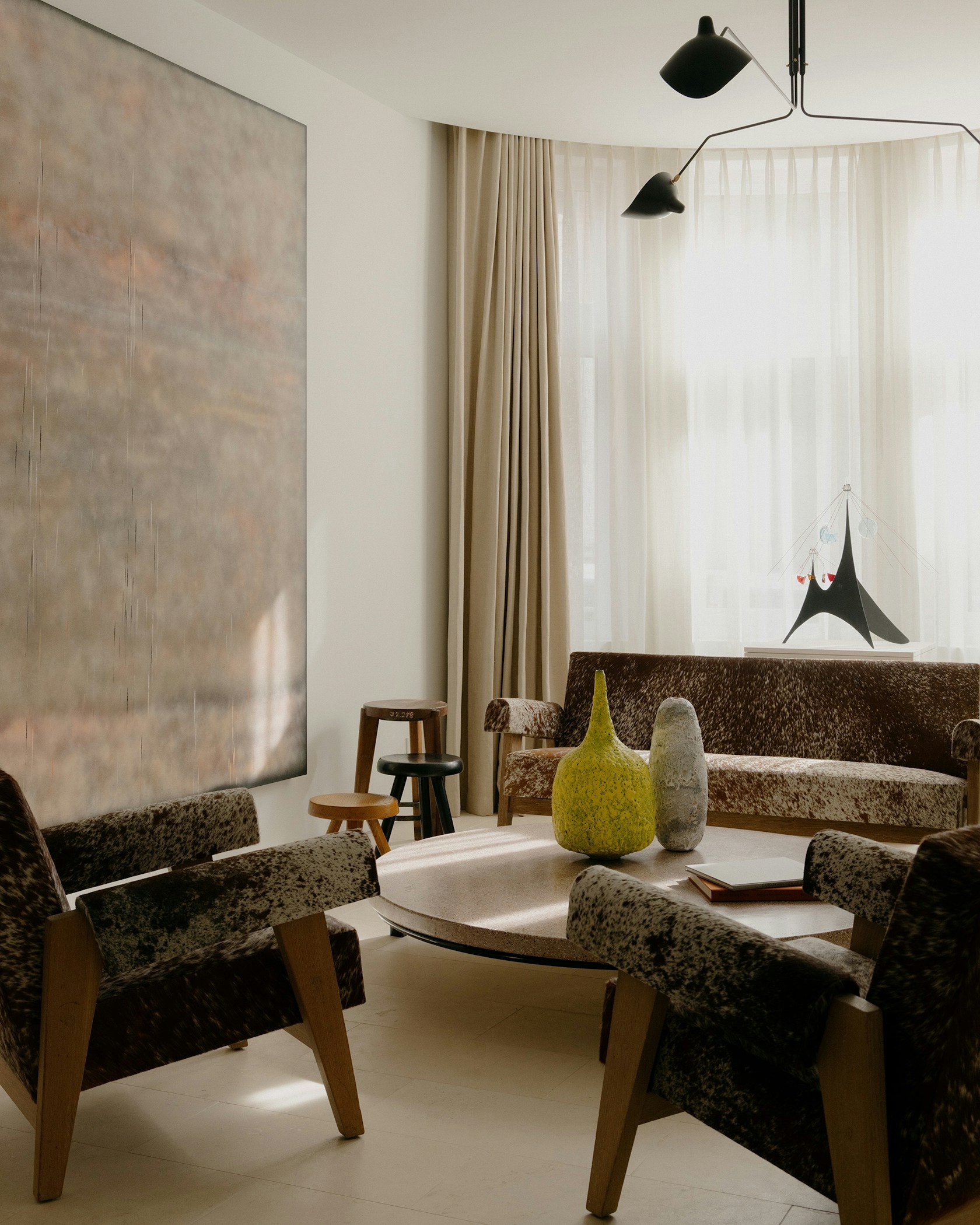
Tina Kim’s New York Townhouse Celebrates the International Artists Who Have Shaped Her
The gallerist’s collection is an astounding representation of her lifelong commitment to expanding Asian artists’ legacies
- By Stephanie Sporn
- Living With Art
For Korean-born, New York-based gallerist Tina Kim, art has always been a family pastime and profession. “Traveling often to see exhibitions and attend art fairs was very much a part of my upbringing. Being in a family that was constantly around art helped me hone my taste and develop my point of view,” says Kim.
Since establishing her eponymous gallery in Midtown Manhattan in 2001 and moving to her current Chelsea location in 2015, Kim has presented exhibitions and programs that reflect her international perspective and interest in artists who are not represented in New York. While in many ways the gallery is responsible for bringing the Korean Dansaekhwa movement of the 1970s to international audiences—with several historical exhibitions for artists such as Ha Chong-Hyun, Park Seo-bo, and Kwon Young-woo—her program also includes artists such as Ghada Amer, Tania Pérez Córdova, and Davide Balliano.
Dansaekhwa masters, such as Lee Ufan and Ha Chong-Hyun, have pride of place in Kim’s Upper West Side townhouse, but so do works by Louise Bourgeois, Anselm Kiefer, and Bill Viola, all with whom Kim has closely collaborated. “The artworks that I have at home are by people I respect greatly and who have hugely influenced my career and me as a person,” says Kim. “Their art crosses all borders and genres, and they don’t speak to a particular audience, which is important to me.”


Kim began collecting drawings and small paintings as a student in New York. One of the earliest pieces she acquired that is still in her home is a 1994 portrait of Matthew Barney, titled Cremaster 4: The Loughton Candidate. At the time, Kim was an intern at Paula Cooper Gallery and was curious about Barney’s multidisciplinary, provocative practice. Eager to learn more, Kim went to Gladstone Gallery across the street where Barbara Gladstone had Kim watch The Cremaster Cycle, which Gladstone co-produced. “These films are excruciatingly long, and I didn’t understand them at first, but was very interested,” says Kim, who swiftly became a Barney convert. After Kim expressed her interest in his art, Cooper sold her a portrait that Gladstone was offering to raise funds for the next Cremaster film. Kim paid for it in stipends over six months—something she often did to acquire great works of art as she began to build her collection.
Today, Kim’s collection has grown from modest sketches to large-scale, private commissions. In her five-story 1890s townhouse, designed by Adam Charlap Hyman of Charlap Hyman & Herrero, Korean artist Haegue Yang created a mesmerizing light installation that is one of the star works in the home’s double-height atrium. “It becomes the space, so it’s dominant, but it also disappears, like blinds in front of a window,” says Kim of the 2018 work Glint Gleam Glow Units. For the project, Yang, who is known for using quotidian objects in her work, used window blinds and LED tubes. “Collaborating with Yang on this project was such a reflection of our respect for one another. She was very mindful of the other artworks in the room, and I designated a specific space for her, knowing her practice. It was the first such private commission Yang ever realized. This kind of partnership was very rewarding,” says Kim.

A pair of 1960s corrugated-steel screens by Jean Prouvé divide the entrance hall from the dining room, which includes a Pierre Jeanneret table, Jean Prouvé chairs, and a painting by Kim Tschang-Yeul. Photo: William Jess Laird. © 2022 Artists Rights Society (ARS). New York / ADAGP, Paris.

The artist’s work hangs above Kim’s dining room, where a pair of 1960s corrugated-steel screens by architect and designer Jean Prouvé divide the space from the kitchen and entrance hall. Prouvé, Charlotte Perriand, and Pierre Jeanneret are among the mid-century talents whose furnishings and objects are found throughout the home—a reflection of Kim’s late husband Jaewoong Chung’s business, Vintage20, which specialized in European furniture and decorative art from this period. In 2008, Kim and Chung organized a collaborative exhibition of works by Alexander Calder and George Nakashima, exemplifying the collectors’ international approach. They acquired a rare 1942 standing mobile by Calder from this exhibition, which became a favorite of their children’s.
The Prouvé panels also serve another important purpose: to help support a Lee Ufan painting—or rather, an entire wall on which the artist painted the grayscale Contemplation at Kim’s 2015 Venice exhibition dedicated to Dansaekhwa artists. “We had to build a specific wall in our dining room to fit the dimension of the painting,” says Kim, who worked with a conservator to successfully move the structure from Venice into her home.
The work by Ufan was not the home’s only tight fit. When moving into the townhouse, Kim was determined to display abstractions by Anselm Kiefer and Sterling Ruby that were too tall for her previous home. For the Kiefer, which faces Yang’s light installation, Kim had a double-height wall constructed. When the Ruby wouldn’t fit through the door, they enlarged the opening by two inches to get it to the living room.

“The artworks that I have at home are by people I respect greatly and who have hugely influenced my career and me as a person” — Tina Kim

While Kim typically gravitates toward abstractions, a notable exception in her collection is Bill Viola’s first flat video work, Union, which dates to 2000. In the piece, a nude couple appears to be screaming. “When I bought it, I was worried that it may be a bit too strong for my children. To my surprise, it never upset them. In fact, my daughter used to stare at it, and it somehow calmed her,” says Kim. “You won’t find many figurative works in my home, but I find this work very universal. It’s about life and humanity.”
Many of Kim’s abstract artworks are embedded with deeper meanings, reflecting her support of artists who explore social and political issues through their works. One such work is Conjunction 21-07, a 2021 mixed-media painting by Dansaekhwa artist Ha Chong-Hyun, whom Tina Kim Gallery represents. The artist was born in 1935, when Korea was still occupied by Japan, and his work poignantly captures the tension of the postwar challenges that he experienced as a young man. “His signature style is that he paints on burlap, pushing the paint through from the back,” explains Kim. “By using a nontraditional material, his work reveals his wish to tear down the existing hierarchy. Burlap represents the people, and his act of pushing the paint through from the back illustrates a resistance to the established authoritarian regime. During the 1970s and ’80s, there were numerous demonstrations led by students. Back then, when the police and military soldiers would arrive, the first thing people would do is fill burlap sacks with sand to build a barrier.” The work hangs in Kim’s bedroom. “I find it calming. It’s not just a beautiful painting; it’s one that shows his life story.”
In her gallery’s program and her own collecting, Kim highlights several Asian-American artists, both new talents and those who were successful during their time but whose legacies have waned. In 2021, the gallery’s exhibition The Unseen Professors presented three Asian-American artists who taught at major New York City schools but whose works are lesser-known today. One such talent is the Japanese artist Minoru Niizuma, whose abstract sculptures were exhibited at MoMA and the Whitney Museum of American Art, among other esteemed institutions. Kim recently started representing the artist’s estate and is working on building his legacy.
Kim is also working with the estate of Filipino-American artist Pacita Abad, whose first-ever survey is planned for 2023 at the Walker Art Center in Minneapolis. Kim is especially inspired by Abad’s Immigrant Experience quilted paintings from the 1980s and ’90s. In this series, the artist documents her experience moving to California from the Philippines, where she was part of an influential political family, and experiencing multiculturalism as well as issues of race and class for the first time.
“As an established gallery in New York, I am in a unique position to offer a platform for artists whose works have not yet been widely recognized,” says Kim. Works by Niizuma and Abad are on her wish list for her personal collection. “I don’t have their work at home yet, but you will definitely see them there next time.”



